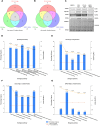Extracellular vesicles with altered tetraspanin CD9 and CD151 levels confer increased prostate cell motility and invasion
- PMID: 29891991
- PMCID: PMC5995928
- DOI: 10.1038/s41598-018-27180-z
Extracellular vesicles with altered tetraspanin CD9 and CD151 levels confer increased prostate cell motility and invasion
Abstract
To facilitate intercellular communication, cells release nano-sized, extracellular vesicles (EVs) to transfer biological cargo to both local and distant sites. EVs are enriched in tetraspanins, two of which (CD9 and CD151) have altered expression patterns in many solid tumours, including prostate cancer, as they advance toward metastasis. We aimed to determine whether EVs from prostate cells with altered CD9 and CD151 expression could influence cellular behaviour and increase the metastatic capabilities of non-tumourigenic prostate cells. EVs were isolated by ultrafiltration and characterised for their tetraspanin expression and size distribution. iTRAQ was used to identify differences between RWPE1 and tetraspanin-modified RWPE1 EV proteomes, showing an enrichment in protein degradation pathways. Addition of EVs from RWPE1 cells with reduced CD9 or increased CD151 abundance resulted in increased invasion of RWPE1 cells, and increased migration in the case of high CD151 abundance. We have been able to show that alteration of CD9 and CD151 on prostate cells alters the proteome of their resultant EVs, and that these EVs can enhance the migratory and invasive capabilities of a non-tumourigenic prostate cellular population. This work suggests that cellular tetraspanin levels can alter EVs, potentially acting as a driver of metastasis in prostate cancer.
Conflict of interest statement
The authors declare no competing interests.
Figures




References
-
- Zöller, M. Tetraspanins and Cancer Metastasis. The Tumor Microenvironment (2010).
-
- Ang J, Lijovic M, Ashman LK, Kan K, Frauman AG. CD151 protein expression predicts the clinical outcome of low-grade primary prostate cancer better than histologic grading: a new prognostic indicator? Cancer Epidemiol. Biomarkers Prev. 2004;13:1717–1721. - PubMed
Publication types
MeSH terms
Substances
LinkOut - more resources
Full Text Sources
Other Literature Sources
Research Materials

